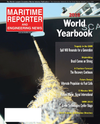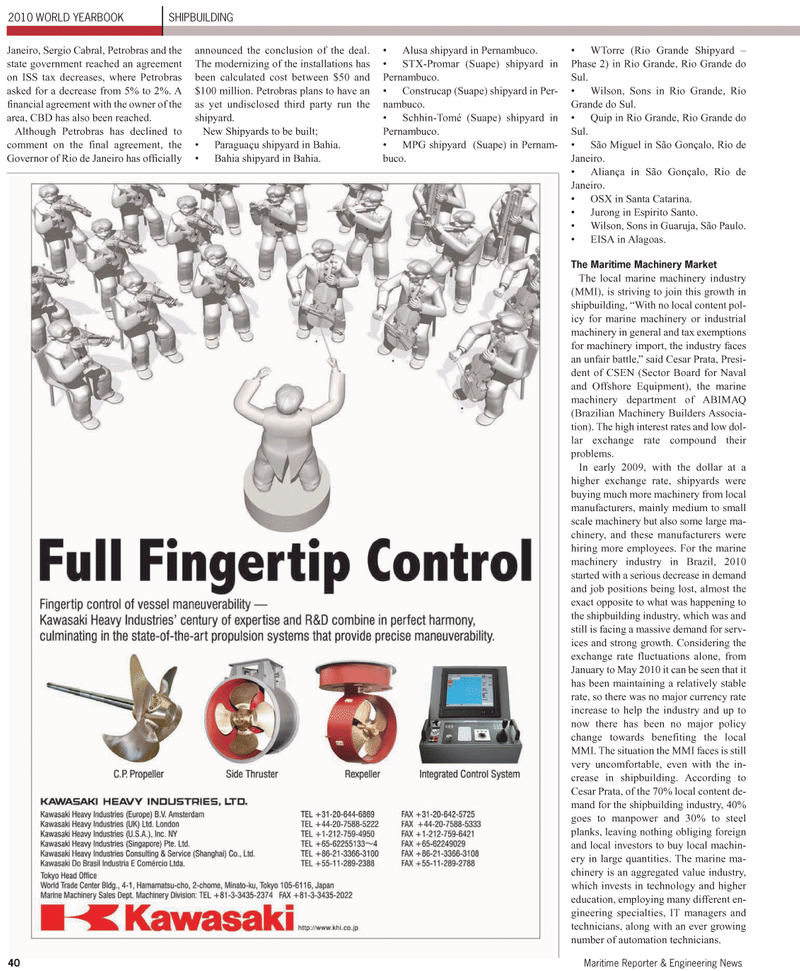
Page 40: of Maritime Reporter Magazine (June 2, 2010)
Read this page in Pdf, Flash or Html5 edition of June 2, 2010 Maritime Reporter Magazine
Janeiro, Sergio Cabral, Petrobras and the state government reached an agreement on ISS tax decreases, where Petrobras asked for a decrease from 5% to 2%. A financial agreement with the owner of the area, CBD has also been reached.
Although Petrobras has declined to comment on the final agreement, the
Governor of Rio de Janeiro has officially announced the conclusion of the deal.
The modernizing of the installations has been calculated cost between $50 and $100 million. Petrobras plans to have an as yet undisclosed third party run the shipyard.
New Shipyards to be built; • Paraguaçu shipyard in Bahia. • Bahia shipyard in Bahia. • Alusa shipyard in Pernambuco. • STX-Promar (Suape) shipyard in
Pernambuco. • Construcap (Suape) shipyard in Per- nambuco. • Schhin-Tomé (Suape) shipyard in
Pernambuco. • MPG shipyard (Suape) in Pernam- buco. • WTorre (Rio Grande Shipyard –
Phase 2) in Rio Grande, Rio Grande do
Sul. • Wilson, Sons in Rio Grande, Rio
Grande do Sul. • Quip in Rio Grande, Rio Grande do
Sul. • São Miguel in São Gonçalo, Rio de
Janeiro. • Aliança in São Gonçalo, Rio de
Janeiro. • OSX in Santa Catarina. • Jurong in Espirito Santo. • Wilson, Sons in Guaruja, São Paulo. • EISA in Alagoas.
The Maritime Machinery Market
The local marine machinery industry (MMI), is striving to join this growth in shipbuilding, “With no local content pol- icy for marine machinery or industrial machinery in general and tax exemptions for machinery import, the industry faces an unfair battle,” said Cesar Prata, Presi- dent of CSEN (Sector Board for Naval and Offshore Equipment), the marine machinery department of ABIMAQ (Brazilian Machinery Builders Associa- tion). The high interest rates and low dol- lar exchange rate compound their problems.
In early 2009, with the dollar at a higher exchange rate, shipyards were buying much more machinery from local manufacturers, mainly medium to small scale machinery but also some large ma- chinery, and these manufacturers were hiring more employees. For the marine machinery industry in Brazil, 2010 started with a serious decrease in demand and job positions being lost, almost the exact opposite to what was happening to the shipbuilding industry, which was and still is facing a massive demand for serv- ices and strong growth. Considering the exchange rate fluctuations alone, from
January to May 2010 it can be seen that it has been maintaining a relatively stable rate, so there was no major currency rate increase to help the industry and up to now there has been no major policy change towards benefiting the local
MMI. The situation the MMI faces is still very uncomfortable, even with the in- crease in shipbuilding. According to
Cesar Prata, of the 70% local content de- mand for the shipbuilding industry, 40% goes to manpower and 30% to steel planks, leaving nothing obliging foreign and local investors to buy local machin- ery in large quantities. The marine ma- chinery is an aggregated value industry, which invests in technology and higher education, employing many different en- gineering specialties, IT managers and technicians, along with an ever growing number of automation technicians. 40 Maritime Reporter & Engineering News 2010 WORLD YEARBOOK SHIPBUILDING

 39
39

 41
41
